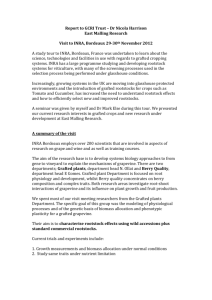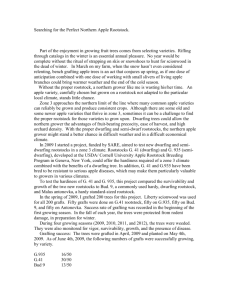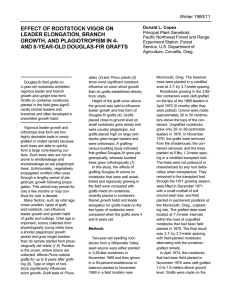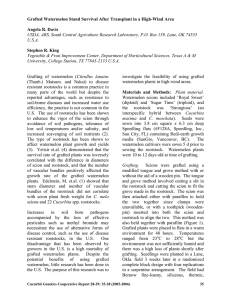Effects of Rootstock Age on Leader Growth, Plagiotropism, and
advertisement
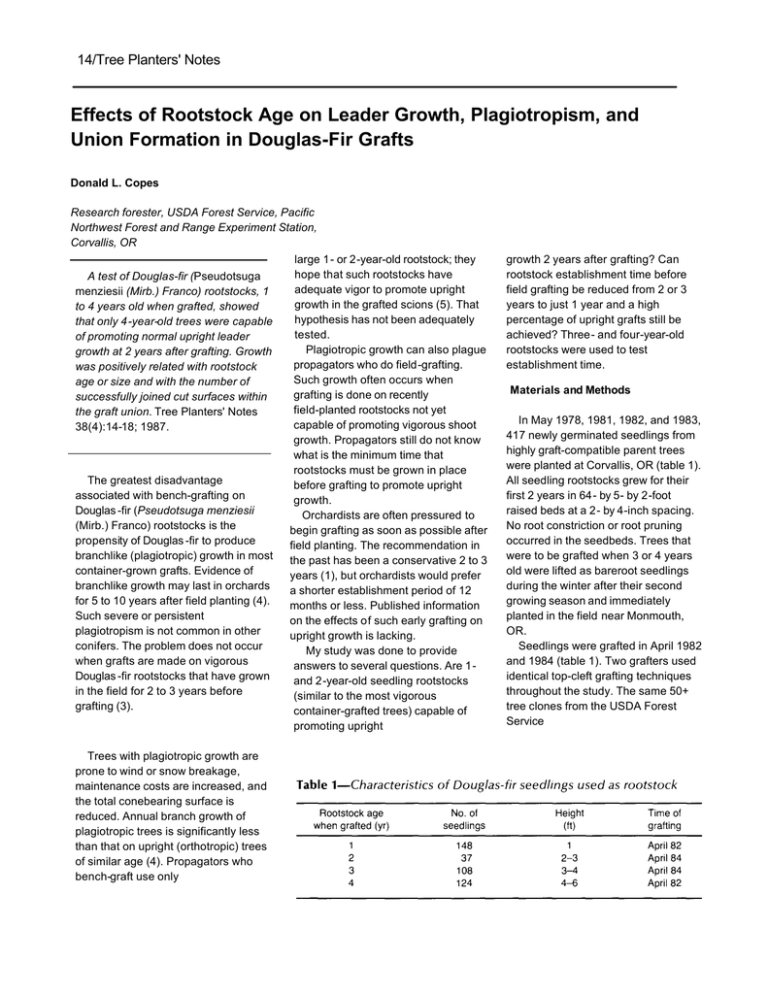
14/Tree Planters' Notes Effects of Rootstock Age on Leader Growth, Plagiotropism, and Union Formation in Douglas-Fir Grafts Donald L. Copes Research forester, USDA Forest Service, Pacific Northwest Forest and Range Experiment Station, Corvallis, OR large 1- or 2-year-old rootstock; they hope that such rootstocks have A test of Douglas-fir (Pseudotsuga adequate vigor to promote upright menziesii (Mirb.) Franco) rootstocks, 1 growth in the grafted scions (5). That to 4 years old when grafted, showed hypothesis has not been adequately that only 4-year-old trees were capable tested. of promoting normal upright leader Plagiotropic growth can also plague growth at 2 years after grafting. Growth propagators who do field-grafting. was positively related with rootstock Such growth often occurs when age or size and with the number of grafting is done on recently successfully joined cut surfaces within field-planted rootstocks not yet the graft union. Tree Planters' Notes capable of promoting vigorous shoot 38(4):14-18; 1987. growth. Propagators still do not know what is the minimum time that rootstocks must be grown in place The greatest disadvantage before grafting to promote upright associated with bench-grafting on growth. Douglas -fir (Pseudotsuga menziesii Orchardists are often pressured to (Mirb.) Franco) rootstocks is the begin grafting as soon as possible after propensity of Douglas -fir to produce field planting. The recommendation in branchlike (plagiotropic) growth in most the past has been a conservative 2 to 3 container-grown grafts. Evidence of years (1), but orchardists would prefer branchlike growth may last in orchards a shorter establishment period of 12 for 5 to 10 years after field planting (4). months or less. Published information Such severe or persistent on the effects of such early grafting on plagiotropism is not common in other upright growth is lacking. conifers. The problem does not occur My study was done to provide when grafts are made on vigorous answers to several questions. Are 1­ Douglas -fir rootstocks that have grown and 2-year-old seedling rootstocks in the field for 2 to 3 years before (similar to the most vigorous grafting (3). container-grafted trees) capable of promoting upright Trees with plagiotropic growth are prone to wind or snow breakage, maintenance costs are increased, and the total conebearing surface is reduced. Annual branch growth of plagiotropic trees is significantly less than that on upright (orthotropic) trees of similar age (4). Propagators who bench-graft use only growth 2 years after grafting? Can rootstock establishment time before field grafting be reduced from 2 or 3 years to just 1 year and a high percentage of upright grafts still be achieved? Three- and four-year-old rootstocks were used to test establishment time. Materials and Methods In May 1978, 1981, 1982, and 1983, 417 newly germinated seedlings from highly graft-compatible parent trees were planted at Corvallis, OR (table 1). All seedling rootstocks grew for their first 2 years in 64- by 5- by 2-foot raised beds at a 2- by 4-inch spacing. No root constriction or root pruning occurred in the seedbeds. Trees that were to be grafted when 3 or 4 years old were lifted as bareroot seedlings during the winter after their second growing season and immediately planted in the field near Monmouth, OR. Seedlings were grafted in April 1982 and 1984 (table 1). Two grafters used identical top-cleft grafting techniques throughout the study. The same 50+ tree clones from the USDA Forest Service Fall 1987/15 Beaver Creek Seed Orchard, 15 miles southwest of Corvallis, were used as scions both years. Standard branch-pruning techniques were applied to rootstocks after grafting to enhance scion growth and promote development of upright leaders. Observations and measurements were recorded in 1984 and 1986 at the end of the second growing season after grafting. Annual leader growth was measured to the nearest 0.5 cm. The degree of branchlike growth was determined by visually classifying the grafts into three different groups: 1 = very plagiotropic or nearly horizontal, 2 = moderate or slightly plagiotropic, and 3 = orthotropic or nearly vertical. The ease with which rootstocks of various ages formed unions after grafting was quantified by counting how many of the four possible vertical-cut surfaces in the top-cleft graft union successfully joined adjacent scion-stock tissues. A knife cut was used to expose the inner cambial area to show the presence or absence of new xylem connecting the stock and scion. Data for annual leader growth was evaluated by analysis of variance (ANOVA). The degree of branchlike 2 growth was tested by chi-square (X ) procedures rather than ANOVA because the data were quantitative. The relation between the number of joined surfaces and the total leader growth with rootstock age is shown in figure 1. Results Data for leader growth, plagiotropism, and union healing of grafts made on 1-, 2-, 3-, and 4-year-old rootstocks are presented in table 2. The significance of three independent comparisons made for leader growth with the various combinations of rootstocks of different ages is shown in table 3. All comparisons, except first-year leader growth of 1- and 2-year-old rootstocks contrasted with similar leader growth of 3- and 4-year-old rootstocks, were significant (P < 0.05) or highly significant (P < 0.01). Cross-tabulation results of the three classes of plagiotropism by the four rootstock age classes showed a highly significant chi-square value (X 2 = 235.994, 6 df). A highly significant difference was noted in a comparison of grafts made on 4-year-old rootstocks and those made on the 1-, 2-, and 3-year-old rootstocks (X 2 = 20.392, 2 df). Ninety-two percent of the grafts made on 4-year-old rootstocks were upright (table 1). but only 14. 5. anal 33% 16/Tree Planters' Notes Discussion of the grafts were upright on 1-, 2-, and 3-year-old rootstocks, respectively. Grafts made on 1-, 2-, and 3-year-old rootstocks had a positive relation with the number of connecting union surfaces and total leader growth (fig. 1). Rootstocks that were 4 years old when grafted did not show a similar trend with the number of connecting areas. The 1- and 2-year-old Douglas -fir rootstocks grafted in raised beds were incapable of promoting upright growth in a majority of the grafted scions. Plagiotropism was the norm even though the rootstocks were free of root constriction and root disturbance. Only 14 and 5% of the land 2-year-old trees, respectively, were upright 2 years after grafting. At the time of grafting, the trees were as large (1 to 3 feet tall) and as vigorous as the best container-grown trees of similar age; thus, the common practice of bench-grafting 1or 2-year-old container-grown Douglas -fir rootstocks appears to have little chance of producing trees with favorable upright growth. If such bench grafting is necessary, the orchardist should realize that it will result in plagiotropic growth characteristics for 5 to 10 years regardless of rootstock size at the time of grafting (4). Reducing the interval between field planting and grafting from 2 Fall 1987/17 years to 1 year greatly increased branchlike growth. Only 33% of the field-planted trees (3 years old) were upright when grafted 1 year after field planting. The 4-year-old rootstocks (2 years in the seedbeds plus 2 years in the field before grafting) promoted orthotropic growth in 91% of the grafts. This study did not determine whether the ability of the 4-year-old rootstocks to promote upright growth resulted from the trees being physiologically more vigorous or if a physical size factor, such as root mass, was involved. Possibly, age and size factors interacted to produce some essential growth hormone that enhanced upright growth. Little plagiotropism occurs when 3-year-old Douglas -fir rootstocks are grafted 1 year after field planting if the rootstocks are well irrigated and fertilized the first summer after planting in the orchard (6). Total leader growth and rootstock age or size were positively correlated-grafts made on older rootstocks had increasingly greater total shoot growth (49, 65, 77, and 92 cm for 1-, 2-, 3-, and 4-year-old trees, respectively). The relation between leader growth and rootstock age or size was not as clear when increments from the first and second years were evaluated separately because average annual leader growth varied greatly be­ tween 1982 and 1984, and different ages of rootstocks were tested each year. Less-than-normal growth occurred in 1982 because of damage from a late-spring frost; normal growth occurred in 1984. A previous study (3) showed first-year scion growth on rootstocks grown 4 years in the field before grafting to be about 35 cm the first year and over 80 cm the second year. Healing of the union seemed to depend on rootstock stem diameter at the point of grafting and vigor (rate of cell proliferation) of the rootstock in promoting the joining of contiguous cut surfaces. Grafts made on 1-year-old rootstocks were the most successful 2 years after grafting (81% had unions on all four faces). This was unexpected because the stem diameters of the 1-year-old rootstocks at the time of grafting were generally much less than those of the scions, yet at least three surfaces had joined on 83% of those rootstocks. Grafts made on 2-year-old rootstocks more closely matched the scion stem diameters, but three or four cut surfaces had successfully joined on only 65%. If a nearly perfect match between the scion and stock cannot be made, grafting scions of slightly larger diameters than the stock may be beneficial because most radial growth the first 3 months after grafting occurs in the rootstock area of the union (2). Such unequal growth between the scion and stock may allow the originally smaller diameter stocks to form a union at a later date on the mismatched side of the graft. The same "catch-up" healing process cannot occur when the stem diameter of the rootstock exceeds that of the scion, and many of the grafts develop scion overgrowths on the mismatched side in later years. The number of connecting cut surfaces in the graft union was positively related with first-year leader growth, but negatively related with second-year growth. Similar first-year results show that leader growth in Douglas -fir is positively correlated with the actual length of connecting cambium in the graft union (2). The accelerated growth in the second-year growth by grafts with only one or two of the four possible surfaces connecting was unexpected and somewhat puzzling. Summary A grafting test on 1-, 2-, 3-, and 4-year-old rootstocks showed that, under the environmental conditions of this test, only the large 4-year-old trees are capable of promoting uniform early upright growth in grafted scions. Of the scions grafted on 4-year-old rootstocks, 91% were upright 2 years after grafting; only 14, 5, 18/Tree Planters' Notes and 33% of the grafts made on 1-, 2-, and 3-year-old trees, respectively, were upright. Cumulative leader growth the first 2 years after grafting was positively related with rootstock age or size because grafts made on older or larger rootstocks grew longer leaders. The greatest leader growth in the year of grafting occurred in unions with the most successfully united cut surfaces. References 1. 4. Copes, D. Influence of cambial contact length on graft survival and leader elongation in Douglas -fir. Res. Note PNW-69. Portland, OR: U.S. Department of Agriculture, Forest Service, Pacific Northwest Forest and Range 2. Experiment Station; 1967.8 p. Copes, D. Graft union formation in Douglas -fir. American Journal of Botany 3. 56(3):285-289; 1969. Copes, D.L. Comparative leader growth of Douglas -fir grafts, cuttings, and seedlings. Tree Planters' Notes 27(3):13-16; 1976. 5. 6. Copes, D.L. Effect of rootstock vigor on leader elongation, branch growth, and plagiotropism in 4- and 8-year-old grafts. Tree Planters' Notes 31(1):11-14; 1980. Wheat, J. One-year-old graftable rootstock. Tree Improvement Newsletter (Industrial Forestry Association Tree Improvement Laboratory, Olympia, WA) 42:5; 1982. Wilber, J. Personal communication. Shelton, WA: Simpson Timber Co.
